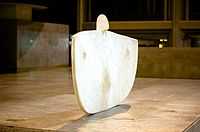Costantino Nivola


Costantino Nivola (July 5, 1911 – May 6, 1988) was an Italian sculptor. The Museo Nivola in Orani, Sardinia, hosts the largest collection of his works. He is the grandfather of actor Alessandro Nivola and father of the acclaimed children's book author Claire Nivola.[1]
Birth and upbringing
Nivola was born and grew up in Orani, a small village in Sardinia. Nivola's family was very poor. As a young adolescent, he worked as an apprentice stonemason in the local building industry.
Artistic life
In Sassari, with the painter Mario Delitala, also from Orani, Nivola had his artistic start, and soon the two worked together for the decoration of some spaces in the local university.He then moved to the Italian mainland, and in 1931 entered the ISIA, the state institute for Artistic Industry in Monza, near Milan. His first official exhibitions are recorded in this period; among many works, notably he produced some xylography, a form of art that would have remained a characteristic expression of Sardinia.
Nivola started then frequenting France (and Paris in particular, where he met Emilio Lussu during his clandestinity), establishing contacts with artists from other countries. Supposedly here he first met his wife, Ruth Guggenheim.
In 1936 he entered the graphics' division of Olivetti, then one of the most important industrial firms in the nation, but in 1939, after Fascism issued racial laws, to protect his wife, he left Italy for France first and the U.S.A. later (Long Island).
Here, in 1940 he became the artistic director for "Interiors" and "Progressive Architecture". In time he became a close friend of Le Corbusier and not without his influences and reflections, Nivola defined his quite surprising technique called "sand-casting". Nivola then provided works for Olivetti showroom in New York (a famous sand-cast relief wall), Mutual Hartford Insurance Company (Connecticut), Harvard University, McCormick Plaza Exposition Center (Chicago) and Yale University.
In 1954 Nivola became a professor and the director of the "Design Workshop" at the Harvard University, while the American Institute of Graphic Arts assigned him its Certificate of Excellence. His academical work increased with other teachings, like in Royal Academy of Fine Arts in Den Haag, Netherlands.
In 1972 the American Academy of Arts and Letters admitted Nivola as its first non-American member. In 1978 the University of California, Berkeley gave him a chair at its Art Department.
He died of a heart attack in Southampton Hospital on Long Island, New York, in 1988.
Nivola's sand casting has been briefly described as a bas-relief sculpture in concrete. Landscape architect Michael Gotkin recently said that Nivola had taken the traditional mediterranean essence of the ancient graffiti and translated it into modern terms. Others suggested that his work expresses a seamless integration of sculpture and architecture.
He produced murals and reliefs for (or together with) a variety of architects including Eero Saarinen, Percival Goodman, Antonin Raymond, Bernard Rudofsky, Richard G. Stein, Carl Stein and others.
References
External links
- Article in The Janesville (Wisconsin) Gazette, June 4, 2012, on the restoration of a 1971 Nivola mural which graces that newspaper's office building.
Books
- Fred Licht, Antonello Satta, Richard Ingersoll, Giorgio Dettori, Nivola: sculture (Milano : Jaca Book, 1991.) Book : Italian : 1. ed. italiana.
- Marika Herskovic, New York School Abstract Expressionists Artists Choice by Artists, (New York School Press, 2000.) ISBN 0-9677994-0-6. p. 18; p. 38; p. 266-269.
- Nivola Fancello Pintori. Percorsi del moderno, ed. by R. Cassanelli, U. Collu and O. Selvafolta, Milano-Cagliari 2003.
- G. Altea, Nivola, Nuoro 2005.
|